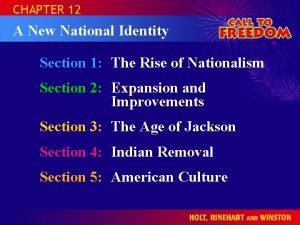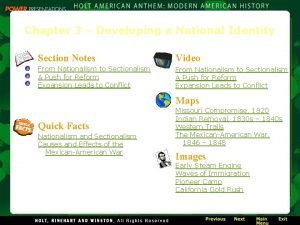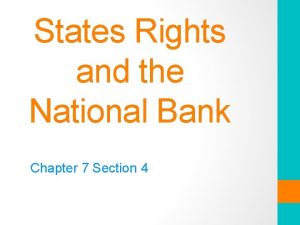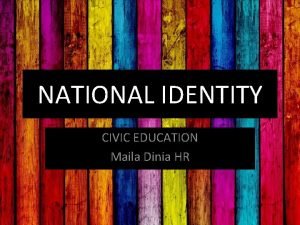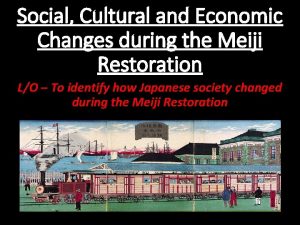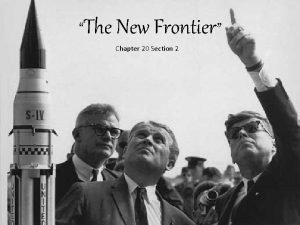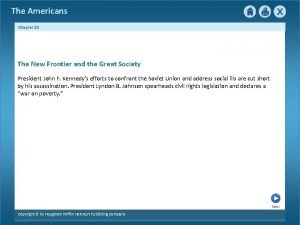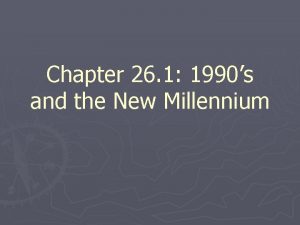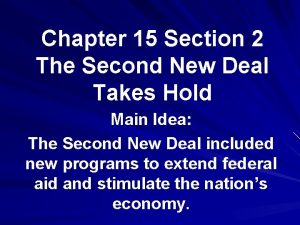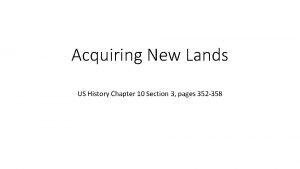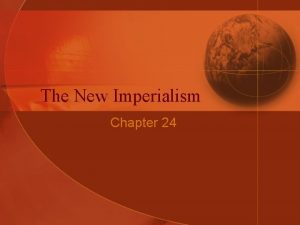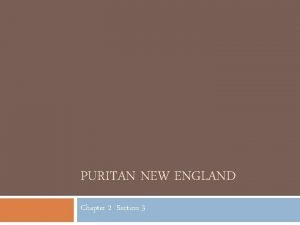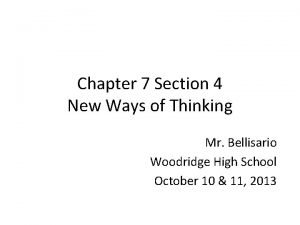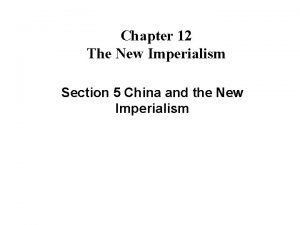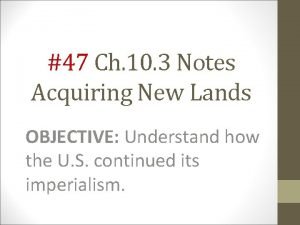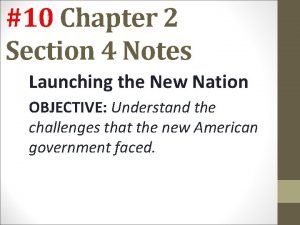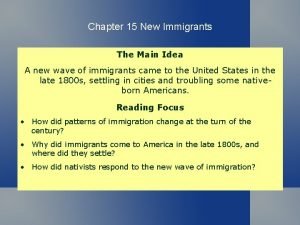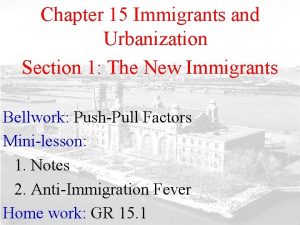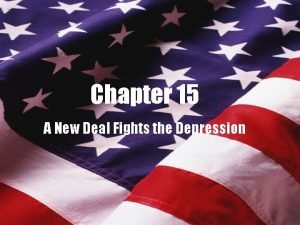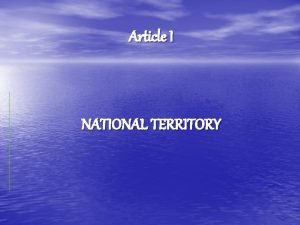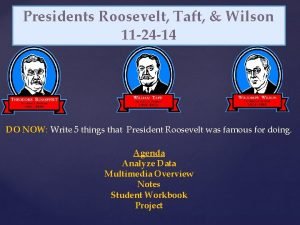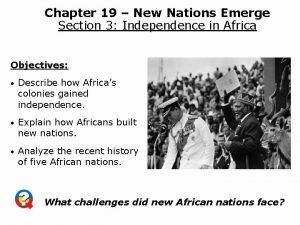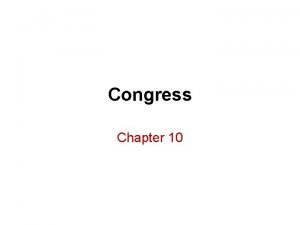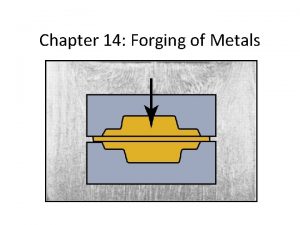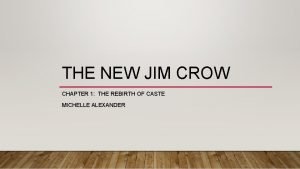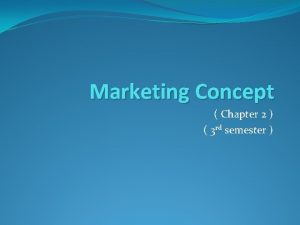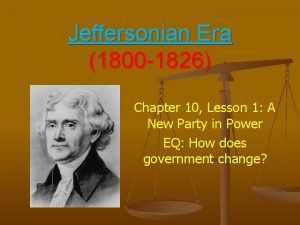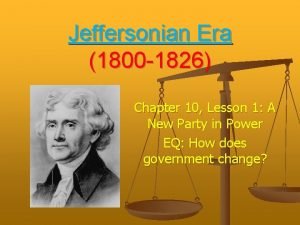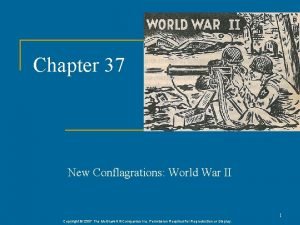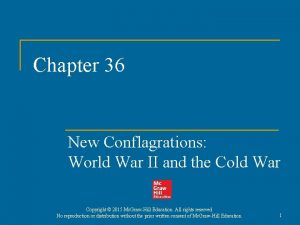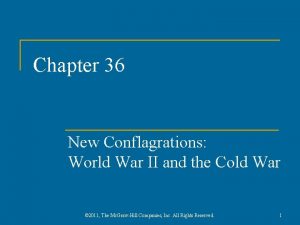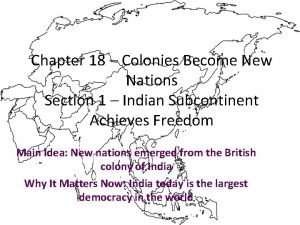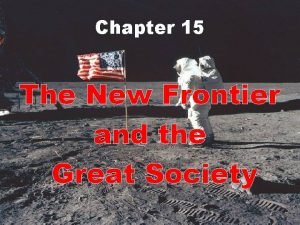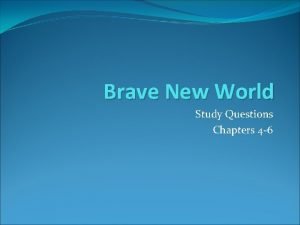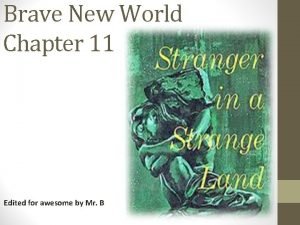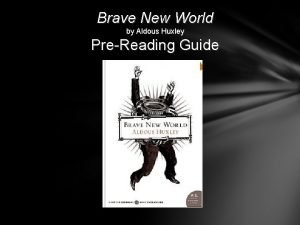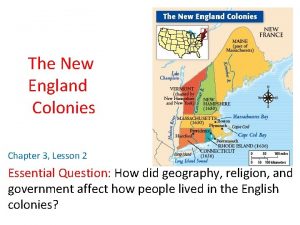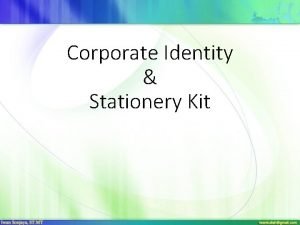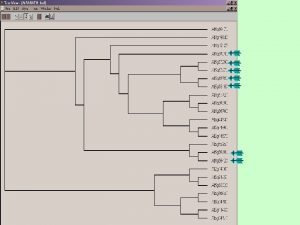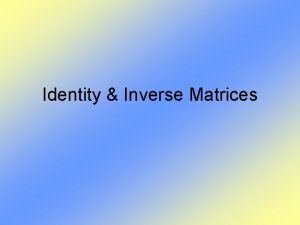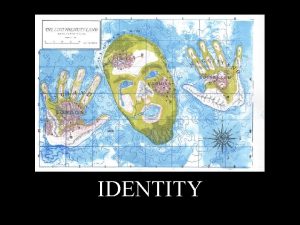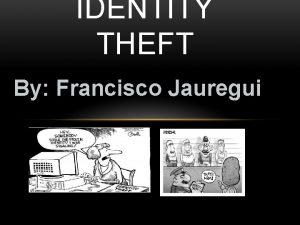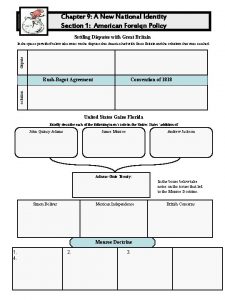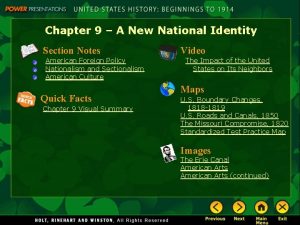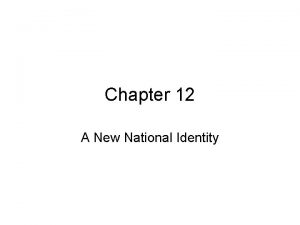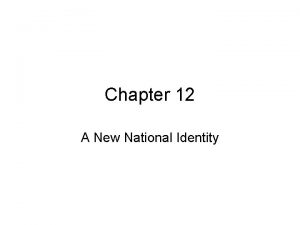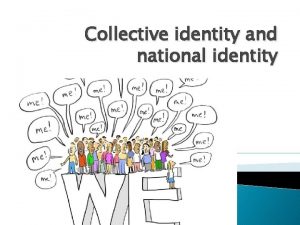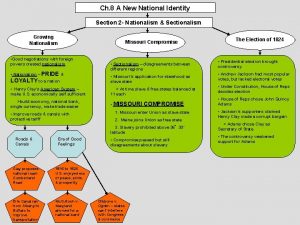CHAPTER 12 A New National Identity Section 1







































































- Slides: 71

CHAPTER 12 A New National Identity Section 1: The Rise of Nationalism Section 2: Expansion and Improvements Section 3: The Age of Jackson Section 4: Indian Removal Section 5: American Culture

SECTION 1 The Rise of Nationalism Era of Good Feelings Who: James Monroe (Dem. Republican) Did What: Was president during the “Era of Good Feelings. ” Signed Rush-Bagot Treaty and Convention of 1818 treaty.

SECTION 1 The Rise of Nationalism Era of Good Feelings When: 1817 Where: United States Why: Era of Good Feelings – Americans were full of National Pride from war. Monroe won reelection in 1820 w/out anybody running against him (Like GW). Rush-Bagot Treaty – Signed over fishing rights conflict with England after War of 1812. Convention of 1818 treaty – Treaty with England that gave us fishing rights off coast of Canada

SECTION 1 The Rise of Nationalism The Issue of Florida Who: John Quincy Adams, Andrew Jackson, President Monroe, Did What: JQA – had talks with Spanish about purchasing Spanish Florida for America. Wrote Adams-Onis Treaty. AJ – Led an army into Spanish Florida to capture and punish a renegade group of Seminole Indians. While in Florida, Jackson took over Spanish military outposts and virtually took over the entire state. President Monroe – heard from Jackson about taking over Florida, but didn’t respond back in time. Gave Spain 2 choices.

SECTION 1 The Rise of Nationalism The Issue of Florida When: 1819 Where: United States, Florida Why: Adams-Onis Treaty – Treaty written by JQA. Gave US Florida, We would pay Spain $5 million and had to give up area that is now Texas. Allowed Spain to Save fact to the world Andrew Jackson – Hated Indians, chased them into Florida and took over Spanish outposts while there. Asked President Monroe if he should fight Spanish, Monroe didn’t respond, so he did it. Enhanced his hero status. President Monroe – Didn’t respond back in time, b/c of time it took to get message and send one back.

SECTION 1 The Rise of Nationalism The Monroe Doctrine Who: President James Monroe, Simon Bolivar Did What: JM – Issued a proclamation to the world to stay out of the business of the Latin and South American countries business. It stated that the US would protect these nations. SB- “liberator”, led many of the struggles of these Latin & South American Countries.

SECTION 1 The Rise of Nationalism The Monroe Doctrine When: December 2, 1823 Where: The Americas Why: Monroe Doctrine – Stated that the US would protect these new democracies and that the European powers (eng, fra, spa, etc…) should stay over in Europe. If they tried to reclaim their colonies, they would have to go through us to do it. This made the US the big dog in this area. We were now a SUPER POWER. The Liberator – Led these struggles to reclaim the lands taken by European countries.

SECTION 1 The Rise of Nationalism Question: How did the United States settle its land disputes with Great Britain and Spain?

SECTION 1 The Rise of Nationalism Compromise with Great Britain Compromise with Spain Rush-Bagot Agreement Terms: Adams-Onis Treaty Terms: • limited naval power on the Great Lakes • Spain gave Florida to the United States. • The United States gave up claims to present-day Texas. • United States took responsibility for up to $5 million of United States citizens’ claims against Spain. Convention of 1818 Terms: • gave the United States fishing rights off parts of Newfoundland Labrador coasts • established a border between the United States and Canada at the 49 th parallel, as far west as the Rockies • agreed to joint occupation of the Pacific Northwest

SECTION 2 Expansion and Improvements The Missouri Compromise Who: Henry Clay, Pro-Slavery people, Anti-Slavery people Did What: HC – Great peacemaker, came up with the idea for the Missouri Compromise. This stopped a major regional conflict (various regions of the country – N vs. S). Had 3 parts: 1. Missouri – Slave State. 2. Main would enter as a Free State. 3. Slavery would be prohibited above the 36/30 parallel. PS- 11 slave states vs. 11 free states. Missouri wanted to be added by a slave state. AS - 11 slave states vs. 11 free states. Did not want Missouri to be allowed to be a slave state.

SECTION 2 Expansion and Improvements The Missouri Compromise When: 1819 Where: US Congress Why: HC – Wanted to stop regional conflict. If you entered 2 states, then the balance of power would remain same. No issues. PS – argued b/c they had fewer reps. In the H. O. R. , they could be blocked by the North. Missouri wanted to be admitted as a slave state. AS – If Missouri were to be admitted as a slave state, that would give slave states power in Senate. This would allow them to do what they wanted. They didn’t want slavery spreading into new territory.

SECTION 2 Expansion and Improvements Internal Improvements Who: Henry Clay Did What: HC – Proposed a strong national economy that would prevent regional conflicts. He proposed a protective tariff. Then the $$ from the tariff could be used to improve the nation internally. This became known as the American System.

SECTION 2 Expansion and Improvements Internal Improvements When: 1815 – 1820’s Where: United States Why: HC – knew a protective tariff would cause Americans to buy domestic goods as opposed to foreign goods. This would create a strong economy. (a protective tariff would make Americans want to buy cheaper American goods. This would benefit the north. With their new found $$, they would purchase the textiles from the south and the south would benefit from the $$. Thus all parts of the Country would help each other and therefore become dependent on each other. This would stop them from fighting. )

SECTION 2 Expansion and Improvements New Roads & Canals Who: American Government, De. Witt Clinton Did What: AG – tried to improve roads in America. Built the Cumberland road which stretched from West Virginia to Illinois. DC – NY Governor. Built the Erie Canal to help speed up travel from Albany to Buffalo. Cost millions of $$ and took 8 years to complete. Well worth it, as NY became the nations top market for goods. The success of the Erie canal set off a canal boom.

SECTION 2 Expansion and Improvements New Roads & Canals When: early 1800’s – mid 1800’s Where: United States, NY Why: AG – early American roads were horrible (dirt, gravel, curdory, turnpike) so to make trade easier, new roads were built. This would speed up transportation of goods and ideas from all areas of the country. First of such road was the Cumberland road. Built and paid for by US Government. First of its kind. Water travel was still cheaper and quicker @ this time, but rivers didn’t go everywhere we needed them to, so canals were started. DC – Spent millions of $$ to build Erie canal. Tough project to complete. Took 8 years to complete. First major undertaking of its time. 363 miles of canal were built. 40 ft. wide, and 4 ft deep. Even went over a 500 ft. hill by using a system of locks. The success of the canal making NY a major trade center, set off a boom in the idea of improving America internally. If we did this, then we could benefit $$.

SECTION 2 Expansion and Improvements The Election of 1824 Who: John Quincy Adams, Andrew Jackson Did What: JQA – Secretary of state, ran for president in 1824. Democratic Republican from the north. Supported higher education. Lost popular vote in election, but with help from Clay, won vote in H. O. R. . Named Clay as his Sec. of State. Did have enough power to push through some of his internal improvements. AJ – Democratic – Republican Senator from Tennessee. Won the popular vote in the election, but didn’t have enough electoral votes to win. Thus went to H. O. R. for tie breaking vote. He lost. Claimed Clay and Adams had made a “Corrupt Bargain. ”

SECTION 2 Expansion and Improvements The Election of 1824 When: 1824 Where: United States Why: JQA – Not very popular with the people. Popularity went down after he named Clay as Sec. of State. Didn’t win popular vote, but won in H. O. R. AJ – Claimed “Corrupt Bargain. ” Said Adams promised Clay favors if he helped him win in the House. Clay was later named Sec. of State. His claims weakened the power of President Adams.

SECTION 2 Expansion and Improvements Question: How did improvements in transportation affect the United States?

SECTION 2 Expansion and Improvements Affect on the United States Improvements Examples Roads Cumberland Road turnpikes connected the East coast to the interior United States Canals Erie Canal provided faster and cheaper routes for goods to market Overall results of improvements in transportation Both resulted in connecting regions of the United States.

SECTION 3 The Age of Jacksonian Democracy Who: Americans (political parties), Andrew Jackson, John C. Calhoun Did What: Americans – Expanding voting rights meant more Americans than ever could vote. (women couldn’t yet) Began holding nominating conventions: public meeting in which people began to select a political parties representatives for president. This allowed more people to become active in politics. Jackson was famous for letting numerous people be involved with his campaigns, and thus this increase in political activism was called Jacksonian Democracy. AJ – Campaigned against Adams for the entire 4 years Adams was president. Kept pushing the idea of the corrupt bargain. Chose John C. Calhoun to run for VP with him in 1828. B/c Adams was also the Dem. Rep. Jackson and his supporters broke off and formed the Democratic party (same one as today) and the Dem. Repub. Eventually started calling themselves just Republicans. JCC – ran as VP under Jackson.

SECTION 3 The Age of Jacksonian Democracy When: 1828 Where: United States Why: Americans – This increase in people getting involved in politics was important to the Election of 1828. Jacksonian Democracy AJ – couldn’t get over being cheated in last election. Wouldn’t be happy until he defeated Adams. JCC – was already important in politics, but now becomes very important as VP.

Andrew Jackson “Old Hickory”

Personality A. Loyal- Wife Rachel and John and Peggy Eaton B. Fierce (violent? )Charles Dickenson, military C. Stubborn/Persistent -Election of 1828

Election of 1828 A. Candidates. Andrew Jackson (Democrat) John Q. Adams (National Republican) B. Negative Campaign. Personalities: -Jackson described as a war hero who had been born poor and rose to success through hard work. He portrayed himself as an advocate of the common man. The NR described him as hot tempered, crude, and ill equipped to be president.

Election of 1828 C. Adams was portrayed by the Democrats as the exact opposite of Jackson. He was seen as a Harvard educated snob. He was also described as being out of touch with everyday people.

Accusations A. Jackson accuses Adams of 1. Being a “leech. ” He says Adams has never had a “real man’s job” b/c he had been in politics his whole lifefollowing in the footsteps of his father (the 2 nd president). 2. Being immoral b/c he had brought a pool table into the White House and he swam naked in the Potomac River every morning for his “morning constitutional. ”

B. Adams accuses Jackson of: 1. Having a wife who was already married! Unfortunately for Jackson, this was true. Rachel Robards Jackson had been married to a man who beat her. She filed for divorce, but in those days it had to go through the state legislature. So, Jackson and Rachel waited a long time, and then got married-only to find out her divorce papers had NOT gone through. It was sorted out and they were remarried, but JQA brought it out in the election. Rachel became very sick soon after the news broke and died. Jackson maintained that Adams had killed her…

Victory for Jackson

A. B. When the election was over, Jackson and his vice president John C. Calhoun had won a record number of popular votes. His victory was seen as a win for the common man. To show their happiness, Jackson’s supporters threw a party on the White House lawn to celebrate his inauguration. This caused a great deal of damage and concern…

Inauguration Party

Jackson’s Presidency

Four Big Issues A. There are four big issues that defined Jackson’s presidency: 1. Tariff of Abomination 2. The Bank Crisis 3. The Nullification Crisis 4. Indian Removal

A. B. C. D. The Tariff of Abomination One of the first challenges Jackson faced as president was a growing regional conflict over tariffs. Northern manufacturers wanted high tariffs to protect their new industries from foreign competition (particularly GB). The South had little industry to protect. Their economy relied on agriculture. High tariffs would anger some of their trading partners, so they wanted a low tariff. Westerners were divided.

Nullification Crisis A. B. C. D. A high tariff was passed in 1828. Southerners called it the Tariff of Abominations (abomination= something hated). Vice President Calhoun led the opposition of the tariff. He wrote a statement in favor of states’ rights. His statement said that states had the right to nullify, or cancel, any federal law they considered unconstitutional. This dispute became known as the Nullification Crisis. Calhoun continued to argue that states had the right to rebel if they felt their rights had been violated. Daniel Webster disagreed saying, “Liberty and Union, now and forever, one and inseparable!” South Carolina (Calhoun’s home state) tested the nullification theory when a new tariff was passed in 1832. The state legislature declared the tariffs of 1828 and 1832 null and void.

Nullification Crisis E. Jackson was strongly against nullification. Because of their difference, Calhoun resigned as VP. F. Jackson said he would send U. S. troops to South Carolina to enforce federal laws. South Carolina officials said they would withdraw from the Union if this happened. G. Henry Clay stepped in and proposed a compromise: 1. Congress will lower the tariff over time. 2. The President has the right to use force to enforce a federal law. H. Both sides agreed to the compromise, but neither side trusted the other.

A. B. C. D. E. The Bank Crisis Jackson was opposed to the Second Bank of the U. S. which Congress had founded in 1816. Many states also opposed the Bank and had taken action against it. Maryland had passed laws that taxed branches of the national bank. James Mc. Culloch, a cashier of the Bank in Maryland, refused to pay this tax. The state took him to court and the resulting case, Mc. Culloch vs. Maryland, went all the way to the Supreme Court. The Court made two important rulings in this case 1. They supported the Bank’s constitutionality. The elastic clause of the Constitution allowed Congress to establish the Bank. 2. The Court also decided that federal law was superior to state law-an idea that challenged the idea of states’ rights. Therefore, Maryland could not tax or interfere with the Bank.

F. G. H. I. J. K. L. The Bank Crisis Nicholas Biddle, the Bank’s director, decided to make the Bank a presidential issue in 1832. The Bank’s charter was up in 1836, but Biddle decided to push it up to 1832. Jackson campaigned against the renewal of the Bank’s charter. He promised he would “kill” any legislation that crossed his desk that would renew the Bank. Congress passed the Bank’s charter and Jackson lived up to his promise by vetoing the bill. Jackson also weakened the Bank’s power by depositing federal funds in state banks (pet banks) instead of the Bank. These pet banks used the federal funds to offer credit to people wanting to buy land. While this policy promoted expansion, it also led to inflation. Jackson tried to combat the inflation by ordering Americans to use only gold and silver to buy land, not paper money. This didn’t help the inflation, but it did lower the national debt.

SECTION 3 The Age of Jackson Van Buren’s Presidency Who: Whig Party, Martin Van Buren, William Henry Harrison Did What: WP - group of people against Jackson formed this political party. Supported the idea of a weak president and a strong congress. Ran 4 candidates against Van Buren. Those 4 split their votes and Van Buren easily won with the support of Jackson. MVB – Won election of 1836 with support of Jackson. Not as well liked as Jackson. Wasn’t seen as a man of the people. Shortly after he took office, country suffered form the Panic of 1837 (mainly caused by Jackson’s policies). In 1840, his reelection was hurt by this depression and he loses to Harrison. WHH - war hero from war of 1812. Ran log cabin campaign. Of the 75% of the nation that voted (compared to 40% of today) it was a close race, but Harrison won in the electoral college by a landslide.

The Panic of 1837

I. Causes A. The government sold millions of acres of land in the West

B. Speculators bought most of the land, to sell at higher prices to others for a profit C. To pay for the land in the first place, speculators borrowed money from banks

D. In order to loan money to the speculators, banks printed more paper money E. The more money that is printed, the less value it has

II. The Panic Begins A. To stop the land speculation, in 1836 Jackson passed a law saying that anyone buying public land had to pay with gold or silver

A. The speculators needed to cash their paper money in for gold and silver B. When the speculators went to the bank, the banks didn’t have enough gold and silver to give everyone their gold and silver C. This caused a bank run

III. Results A. The bank runs turned into a panic B. Banks failed and went out of business C. The Panic was made worse because cotton prices went down so Southerners made less money than ever and were not able to pay back their loans D. Three years of economic depression followed E. President Van Buren, elected in 1836, was blamed for the depression, and did not win re-election

Presidents After Jackson I. Van Buren (Democrat) A. Elected in 1836 B. Blamed for the Depression following the Panic of 1837 C. Only served one term

II. William Henry Harrison (Whig) A. Elected in 1840 Died of pneumonia less than a month after taking office

III. John Tyler (Democrat turned Whig) A. Came to office when Harrison died B. Changed to Whigs after office. Both parties didn’t trust him

C. Tyler disagreed with most of the Whig policies, so not much was accomplished during his presidency D. Tyler was eventually kicked out of the Whig party

SECTION 3 The Age of Jackson Van Buren’s Presidency When: 1836 - 1840 Where: United States Why: WP – Called Jackson “King Andrew”. They wanted a president that ran the govt. Not ran over the govt. MVB – was seen as a rich man. Not as well liked as Jackson. Took the blame for policies that Jackson started. WHH - ran Jackson like campaign against MVB. Used Log Cabin reference to get people to vote for him. He and John Tyler won a close popular vote, but won with a landslide in the electoral college.

SECTION 3 The Age of Jackson Question: How did tariff disputes lead to the nullification crisis and how did President Jackson respond?

SECTION 3 The Age of Jackson STEPS LEADING TO THE NULLIFICATION CRISIS Southern states asserted their right to nullify protective tariffs, which they argued hurt their economy. Jackson condemned nullification. Jackson threatened to send federal troops to South Carolina to enforce federal laws.

SECTION 4 Indian Removal The Indian Removal Act Who: Andrew Jackson, Bureau of Indian Affairs, Choctaw Indians Did What: AJ - pressured Congress to pass the Indian Removal Act of 1830. Forced the removal of all Indians east of Mississippi to land West (Oklahoma). Established Indian Territory. BIA - Created by congress to oversee federal policy toward American Indians. CI - Choctaw Indians were the first Indian group to be removed. Forced to leave during winter of 1831 -32. Federal government didn’t provide enough food or shelter. Thus almost 25% of Choctaw died. Their treatment by the government made many other Indian tribes resist moving.

SECTION 4 Indian Removal The Indian Removal Act When: 1830 Where: United States Why: AJ – pressured Congress b/c he hated the Indians and they were on land that Americans wanted. BIA – The US government had a history of letting down the Indians and this group was supposed to stop them. They failed miserably. CI - Signed the Treaty of Dancing Rabbit Creek - gave up 7. 5 million acres. Lost 25% of their Indians to the move from Mississippi to Oklahoma.

SECTION 4 Indian Removal The Trail of Tears Who: Cherokee Nation (Sequoya), John Marshall, Worcester v. Georgia, Andrew Jackson Did What: CN - didn’t want to move off lands. Heard statements that they were savages and learned the ways of the white man to prove them wrong. Sequoya was a Cherokee that developed a written language so that they could be called civilized and maybe not be picked on anymore. Fought being moved from Georgia to Oklahoma. Forced to move. Disease and the 800 mile trip took its toll, killing almost 5, 000 Cherokee. JM - Chief Justice that ruled in favor of the Cherokee in regards to the trail of tears. Said Georgia (with help from Jackson) had no constitutional right to remove them. Court Case was Worcester v. Georgia. Wv. G - Court case where Cherokee sued for the rights to stay on their land not be kicked out by Georgia. John Marshall ruled in their favor. AJ - Said Georgia had the right to kick them out even though Supreme Court ruled otherwise. Said, “ John Marshall has made his decision, now let me see him enforce it !!!” Hated the Indians.

SECTION 4 Indian Removal The Trail of Tears When: 1832 Where: United States Why: CN – Sued b/c they proved they weren’t savages and felt they should be protected by the laws of the US. JM – Said removal of Cherokee was unconstitutional. Angered many Americans. Wv. G - Important Supreme Court Case. 1 st time Executive Branch and Judicial Branch went toe to toe. AJ - Hated Indians. Famous quote about Constitution and John Marshall.

Jackson & the Indians I. 2 Opinions on what to do with the Indians A. Assimilation: Indians adopt white ways and integrate into white society B. Removal: Move the Indians to land to the West of the Mississippi

Indian Removal II. Cherokees A. The Cherokees decided that they would assimilate in order to keep their land in Georgia. B. They had an alphabet for their language, they had a system of government modeled after the United States, they had settled farms, and some even owned slaves. C. The government of Georgia still kept threatening to take Indian lands

Indian Removal III. Cherokee Nation vs. Georgia A. In 1828, gold is discovered on Cherokee land in Georgia B. People started moving into designated Cherokee land to look for gold. C. The Cherokees hired good lawyers and sued Georgia for not keeping people off of their land. D. The Chief Justice of the Supreme Court, John Marshall, said that the court did not have jurisdiction over their case and the case was dismissed.

Indian Removal IV. Worchester vs. Georgia A. Georgia passed a law saying that all non. Indians on Indian land had to register with the state of Georgia. B. A man named Worchester trespassed without registering. C. The state of Georgia fined him, and he sued the state, claiming that they had no authority over Indian land, only the United States did. D. Chief Justice, John Marshall, said that the Georgia law was unconstitutional because Georgia did not have the right to make laws over the Indians.

Indian Removal IV. Worchester vs. Georgia D. President Jackson SHOULD have backed up the Supreme Court and protected the Cherokee, but when he heard about the decision Jackson said, “Marshall has made his decision, now let him enforce it!”

Indian Removal V. The Trail of Tears A. In the end, the Cherokees were forced to leave their homes in Georgia and walk to Indian Territory in present-day Oklahoma. B. The first group of Indians were forced out of their homes at gun-point and held in prison camps. C. They were then made to walk (or ride in a poorly constructed boat) to Oklahoma. D. An estimated 4, 000 Indians died from hunger, exposure, and disease along the way. E. When the Indians got to Indian Territory, there was no food or shelter for them.

SECTION 4 Indian Removal Question: Why did federal and state governments begin an American Indian removal policy?

SECTION 4 Indian Removal Reasons for American Indian Removal Policy to end disputes between American Indians and settlers to open up American Indian land to settlers

SECTION 5 American Culture American Tales Who: Washington Irving Did What: WI - one of the first American writers to gain international fame. Wrote: Rip Van Winkle, Legend of Sleepy Hollow. Often wrote stories about American History. Blended writing of Europe with America. When: Early 1800’s Where: United States Why: WI - With things changing in America, a lot of things changed. One thing was American Culture. For example, stories about people no longer dominated readings. Stories about American History now ruled the times. People in America were very proud of how things have changed in the past 50 years and they were writing about what made them proud. One early writer that mixed European humor with American History was Washington Irving. His tales of Rip Van Winkle (a man who falls asleep before the American Revolution and wakes 20 years later to a time he doesn’t even recognize) were very popular.

SECTION 5 American Culture James Fennimore Cooper Who: James Fennimore Cooper Did What: JFC - wrote stories about the American Frontier. Fused Irvings writing about American History and fiction. He would put fictional characters in historical events (last of the Mohicans - about French & Indian War) When: 1820’s Where: United States Why: JFC - His new style became very popular in America. Putting Fictional characters in real events allowed his readers to have some knowledge about what was happening, but still use their imagination b/c of the unknown characters.

SECTION 5 American Culture Catharine Maria Sedgwick Who: Chatarine Maria Sedgwick Did What: CMS - wrote stories about the American life, but used women as heroines rather than some weak person that always had to be saved. Brought the ideas of equality for women in books and thus to a mass of people. When: 1820’s Where: United States Why: CMS - Used her ability to write to promote women’s issues. Things like equality, or marriage for women were brought to the public through her books.

SECTION 5 American Culture A New Style of Art Who: Hudson River School, Thomas Cole, George Caleb Bingham Did What: HRS - Inspired by writers like Irving and Cooper, these painters took the ideas of painting old European themes of the past and changed them to include American scenery. These painters were proud of their American life and wanted it to show in their paintings. When: 1820’s - 1840’s Where: United States Why: HRS - These painters were proud of their American life and wanted it to show in their paintings. People like Thomas Cole and George Caleb Bingham were among the leaders of these new American Painters.

SECTION 5 American Culture Question: What topics did favorite writers of the early 1800 s write about?

SECTION 5 American Culture FAVORITE AMERICAN WRITERS OF THE EARLY 1800 s Writers Washington Irving, James Fenimore Cooper, Catharine Maria Sedgwick Subjects American Revolution, settlement, and the landscape

CHAPTER 12 Chapter Wrap-Up 1. How did the United States settle its border disputes with British Canada and Spanish Florida? 2. How did U. S. political parties change between the elections of 1820 and 1828? 3. What did Chief Justice John Marshal decide in Mc. Culloch v. Maryland Worchester v. Georgia, and how did these cases affect the power of state governments?
 A new national identity section 1
A new national identity section 1 A new national identity section 1
A new national identity section 1 Social identity mapping
Social identity mapping The national legislature chapter 10
The national legislature chapter 10 Chapter 7 section 4 states rights and the national bank
Chapter 7 section 4 states rights and the national bank National identity
National identity Meiji restoration samurai
Meiji restoration samurai Chapter 16 toward a new heaven and a new earth
Chapter 16 toward a new heaven and a new earth Chapter 20 section 2 the new frontier
Chapter 20 section 2 the new frontier Chapter 15 section 3 the new deal affects many groups
Chapter 15 section 3 the new deal affects many groups The americans chapter 28
The americans chapter 28 Chapter 26 section 1 the 1990s and the new millennium
Chapter 26 section 1 the 1990s and the new millennium Chapter 15 section 2 the second new deal
Chapter 15 section 2 the second new deal Platt amendment significance
Platt amendment significance Chapter 24 section 5 china and the new imperialism
Chapter 24 section 5 china and the new imperialism Chapter 2 section 3 puritan new england
Chapter 2 section 3 puritan new england Chapter 7 section 4 new ways of thinking
Chapter 7 section 4 new ways of thinking Chapter 12 section 5 china and the new imperialism
Chapter 12 section 5 china and the new imperialism Acquiring new lands section 3
Acquiring new lands section 3 Chapter 2 section 4 launching the new nation
Chapter 2 section 4 launching the new nation Chapter 15 section 1 the new immigrants
Chapter 15 section 1 the new immigrants Chapter 15 section 1 the new immigrants
Chapter 15 section 1 the new immigrants The new deal fights the depression
The new deal fights the depression Chapter 2 section 3 puritan new england
Chapter 2 section 3 puritan new england Chapter 10 meiosis 1 and meiosis 2
Chapter 10 meiosis 1 and meiosis 2 National unification and the national state
National unification and the national state New zealand official languages english
New zealand official languages english Three fold division of navigable waters
Three fold division of navigable waters Split direct speech
Split direct speech New york pennsylvania new jersey delaware
New york pennsylvania new jersey delaware Fresh oil, new wine scripture
Fresh oil, new wine scripture Marquis theatre
Marquis theatre Strengths and weaknesses of the articles of confederation
Strengths and weaknesses of the articles of confederation New-old approach to creating new ventures
New-old approach to creating new ventures Slidetodoc.com
Slidetodoc.com New years old is new again
New years old is new again New classical and new keynesian macroeconomics
New classical and new keynesian macroeconomics Both new hampshire and new york desire more territory
Both new hampshire and new york desire more territory New classical and new keynesian macroeconomics
New classical and new keynesian macroeconomics Comparing the progressive presidents
Comparing the progressive presidents New nations emerge section 2 quiz
New nations emerge section 2 quiz Riverview towers new albany indiana
Riverview towers new albany indiana Forging a new deal section 1 answers
Forging a new deal section 1 answers New movements in america section 1
New movements in america section 1 Revolved section example
Revolved section example Removed section
Removed section Full section
Full section What is the definition of chemical potential energy
What is the definition of chemical potential energy The national legislature chapter 10
The national legislature chapter 10 Barrelling in forging
Barrelling in forging The new jim crow chapter 1
The new jim crow chapter 1 The new jim crow chapter 2
The new jim crow chapter 2 The colonies become new nations
The colonies become new nations New concept chapter 2
New concept chapter 2 Lord of the flies sparknotes chapter 4
Lord of the flies sparknotes chapter 4 Chapter 10 lesson 1 a new party in power
Chapter 10 lesson 1 a new party in power Chapter 10 lesson 1 a new party in power
Chapter 10 lesson 1 a new party in power Launching the new republic
Launching the new republic Chapter 37 new conflagrations world war ii
Chapter 37 new conflagrations world war ii Chapter 36 new conflagrations
Chapter 36 new conflagrations Chapter 36 new conflagrations
Chapter 36 new conflagrations The colonies become new nations
The colonies become new nations Brave new world chapter 16
Brave new world chapter 16 Chapter 15 the new frontier and the great society
Chapter 15 the new frontier and the great society Brave new world questions
Brave new world questions Chapter 6 brave new world
Chapter 6 brave new world Brave new world chapter 1
Brave new world chapter 1 Brave new world chapter summary 1-3
Brave new world chapter summary 1-3 Brave new world ch 11
Brave new world ch 11 Brave new world caste system
Brave new world caste system Getting a driver license illegally may result in:
Getting a driver license illegally may result in: Colony
Colony
